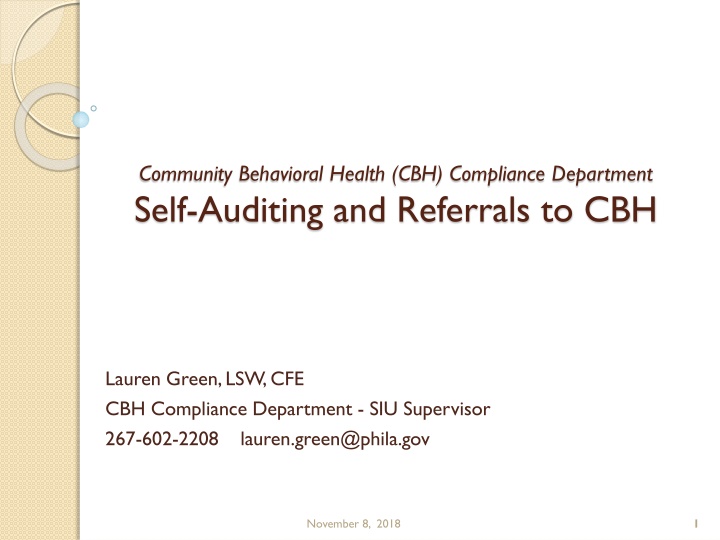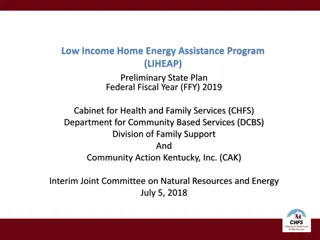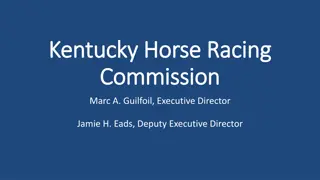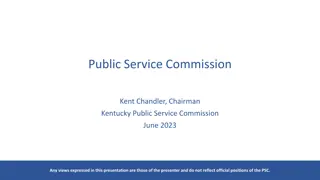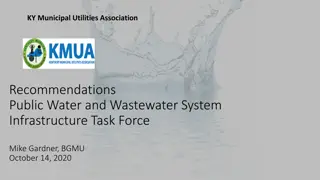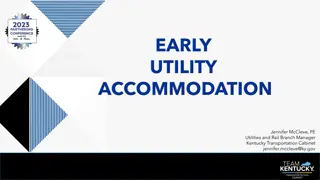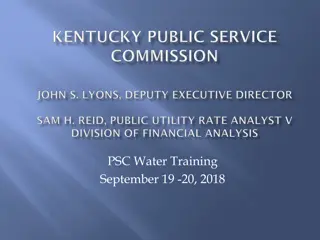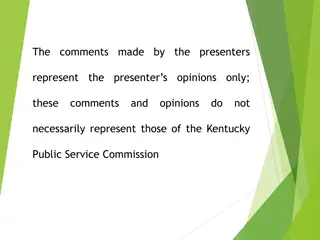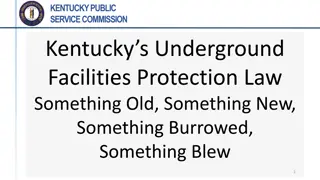Impact of COVID-19 on Utilities in Kentucky Public Service Commission
The presentation discusses the COVID-19 impact on utilities regulated by the Kentucky Public Service Commission, including responses, challenges, and operational changes. It covers moratoriums on disconnects, PSC's initial and internal responses, and data evaluation amid the pandemic.
Download Presentation

Please find below an Image/Link to download the presentation.
The content on the website is provided AS IS for your information and personal use only. It may not be sold, licensed, or shared on other websites without obtaining consent from the author.If you encounter any issues during the download, it is possible that the publisher has removed the file from their server.
You are allowed to download the files provided on this website for personal or commercial use, subject to the condition that they are used lawfully. All files are the property of their respective owners.
The content on the website is provided AS IS for your information and personal use only. It may not be sold, licensed, or shared on other websites without obtaining consent from the author.
E N D
Presentation Transcript
Community Behavioral Health (CBH) Compliance Department Self-Auditing and Referrals to CBH Lauren Green, LSW, CFE CBH Compliance Department - SIU Supervisor 267-602-2208 lauren.green@phila.gov November 8, 2018 1
Learning Objectives At the conclusion of this presentation, participants will have a better understanding of: oSelf-Auditing oImproper Payments oThe Benefits of Self-Auditing oFederal Health Care Fraud Laws oThe Basics of the Self-Audit Process oThe DHS MA Provider Self-Audit Protocol oSelf-Auditing Forms and CBH Referral Process 2
Incorporate Self-Auditing In Your Compliance Plan US Department of Health and Human Services, Office of Inspector General (HHS-OIG) Periodic internal monitoring and auditing is one of the seven key elements of an effective compliance program: Conduct internal monitoring and auditing. Implement compliance and practice standards. Designate a compliance officer or contact. Conduct appropriate training and education. Respond appropriately to detected offenses and develop corrective action. Develop open lines of communication. Enforce disciplinary standards through well-publicized guidelines. 1. 2. 3. 4. 5. 6. 7. 3
Incorporate Self-Auditing In Your Compliance Plan DHS MA Provider Self-Audit Protocol (2001) Recommends that providers conduct periodic audits. providers have an ethical and legal duty to promptly return inappropriate payments that they have received from the MA program. protect the financial integrity of the MA program. Medical Assistance Bulletin #99-02-13 Pennsylvania s Department of Human Services (DHS) Medical Assistance (MA) Self-Audit Protocol encourages MA providers to implement compliance plans, and to utilize self-audit procedures to review their records periodically for potential regulatory violations and overpayments. 4
Self-Audit Definition Centers for Medicare & Medicaid Services (CMS) A self-audit is an audit, examination, review, or other inspection performed by and within a physician s or other health care professional s business. Self-audits generally focus on assessing, correcting, and maintaining controls to promote compliance with applicable laws, rules, and regulations. a self-audit is audit work that the entity does for itself. 5
Benefits to Self-Auditing Self-Audit Toolkit (CMS) o Reduce and prevent fraud and improper payments o Lower chances of an external audit o Help create a robust culture of compliance o Ensure that claims submitted are true and accurate o Speeding up and optimizing proper claim payment o Improve client care o Minimize billing mistakes o Showing a good faith and diligent commitment to a robust compliance effort o Sending the message to staff that while mistakes will occur, employees have a duty to report errors and fraud so they may be corrected o Avoid conflicts with self- referral and anti- kickback statutes 6
Benefits to Self-Auditing Question Answered by the Audience Can you identify additional benefits to self-auditing? To forecast problems To improve the culture of the organization For tracking and trending purposes To gauge the temperature of programs To assess the impact of training To improve internal processes For planning purposes and to make changes as needed To develop a risk assessment To improve EMR / EHR functioning For program development To determine a budget for payments that need to be paid back 7
Federal Laws Against Health Care Fraud CMS US Government Accountability Office has designated Medicaid as a program at high risk for: Improper Payments - payments for treatments or services that were not covered by program rules, that were not medically necessary, or that were billed for but were never provided. Divert resources away from necessary care May subject health care professionals to recoupment If the result is fraud or abuse, may also incur criminal penalties and other sanctions 8
Federal Laws Against Health Care Fraud Self-Audit Toolkit (CMS) Improper Payments generally occur when services are: Not documented Not rendered Not covered Not medically necessary Double-billed Misrepresented Incorrect location, date, time, sequence, frequency, quantity, description, staff licensure, etc. Upcoded Unbundled 9
Federal Laws Against Health Care Fraud CMS Fact Sheet Sanctions under Federal law can take form of administrative, civil, and criminal penalties, ranging from monetary fines and damages to prison time and exclusion from Federal Health Care program. oHealth Care Fraud Statute oFalse Claims Act oAnti-Kickback Statute oCivil Monetary Penalties Law oExclusion Provisions Medicaid Providers are responsible for knowing the law 10
Self-Disclosure False Claims Act Penalties for Non-Disclosure: Act established liability for any person knowingly presenting or causing to be presented a false or fraudulent claim to the federal government for payment Significant civil and criminal penalties, significant monetary penalties, possibly of exclusion Examples of Potential Violations: o Upcoding o Billing for unnecessary services o Billing for services not provided o Billing for services performed by an excluded individual 11
Self-Disclosure Self-Audit Toolkit (CMS) Potential benefits of self-disclosing: o Lower damages amounts that are sought in government-initiated investigation and/or litigation o Less potential exposure under False Claims laws o Possible release from permissive exclusion and corporate integrity measures If improper claims are found, overpayments must be returned 12
Ways Self-Audits are Initiated Risk assessments Current issues Management requests Regular rotations Industry guidance 13
Ways Self-Audits are Initiated Question Answered by the Audience Can you identify other ways self-audits are initiated? Through member complaints Through funding that requires self-auditing By external audits Through routine quality reviews By clinical documentation reviews and supervision Through service verification such as outreach Seeing a lack of client improvement 14
Ways Self-Audits are Initiated CMS Comprehensive Program Integrity Review of Pennsylvania (2012) Report highlights two types of self-auditing programs put forth by PA DHS as effective practice towards maintaining program integrity: Provider-Initiated Self-Audits - providers identify potential violations through internal policy-standard monitoring protocols, perform audits on their own records Providers are to report their findings, submit corrective action plans, and return any inappropriate payments. Third-Party Initiated Provider Self-Audits - initiated by Bureau of Program Integrity (BPI), CBH, etc. The provider is notified of an issue found through various mechanisms such as data mining or on-site audits and requested to complete a self- audit. 15
The Self-Audit Process 4 General Steps Self-Audit Toolkit (CMS) 1. Identify the Risks a. Conduct Risk Assessment b. Assess and Score Risk 2. Audit the Risks a. Review of Standards and Procedures b. Claims Audits 3. Document the Audit 4. Review and Act on Results 16
The Self-Audit Process Step 1 - Identify Risks Identify risks by completing a Risk Assessment Risk Assessment a methodological, measured, and proactive approach to compliance and control. The risk assessment helps to identify your key priorities for the focus of your compliance program. Starts with identifying and prioritizing known and suspected risks. 17
The Self-Audit Process Step 1 - Identify Risks Two Key Questions to Answer in a Risk Assessment: 1. Which compliance issues and risks are of GREATEST concern? Does a risk exist (existence)? Does it matter (significance)? How much does it matter (materiality)? 2. Where are you most vulnerable to these risks? 18
The Self-Audit Process Step 1 - Identify Risks Question Answered by the Audience What are some common risks areas? Training staff Quality of work life Unhappy employees The ability to copy and paste in EMR/EHR Templates and pre-loaded goals and interventions Checklists/boxes in notes Issues with electronic encounter forms Poor supervision Pressure to bill a set amount of units Treatment plans Mobile staff Not addressing needs of clients 19
The Self-Audit Process Step 1 - Identify Risks OIG Work Plan Highlights areas of government focus: http://oig.hhs.gov/reports-and-publications/workplan/index.asp Risk Assessments should involve input from relevant departments, including: Medical Clinical Billing/Accounting IT Legal/Compliance 20
The Self-Audit Process Step 1 - Identify Risks Question Answered by the Audience Whose input would you request during the risk assessment process to identify the risks and why? Frontline staff Data reports Exit interviews/human resources Focus groups with members Consultants Consumer satisfaction surveys 21
The Self-Audit Process Step 1 - Identify Risks Assess and Score Risk Self-Audit Toolkit (CMS) highlighted the American Institute of Certified Public Accountants (AICPA) approach to assessing risks: High (3) risks that repeat, are hard to detect, are very likely to occur, of significant impact Medium (2) risks occurring less often, difficult to detect Low (1) unlikely risks, small potential impact 22
The Self-Audit Process Step 1 - Identify Risks Question Answered by the Audience Who would be involved in conducting your risk assessment and why? Program Directors / Administration Dedicated Compliance Staff Interdepartmental / Cross Organizational members Input from Quality One individual recommended receiving support from the Board and Administration 23
The Self-Audit Process Step 1 - Identify Risks Assess and Score Risk BASIC MODEL HIGH=3 Medium=2 Low=1 Control Area Scorer 1 Scorer 2 Scorer 3 Average Documentation 1 1 2 1.33 Policy 2 1 2 1.67 Training 2 3 1 2.00 Monitoring 3 2 2 2.33 24
The Self-Audit Process Step 2 Audit the Risks Two-Part Process A. Review of Standards and Procedures o Manage Internal Control and Compliance o Limit Behavior and Manage Risk B. Claims Audits o Claims audits involve reviewing bills and medical records for compliance with applicable coding, billing, and documentation requirements. 25
The Self-Audit Process Step 2 Audit the Risks A. Standards and Procedures The Self-Audit Toolkit (CMS) states operational standards and procedures should demonstrate the nature, scope, and timing of your organization s compliance-related activities. The Toolkit recommends periodic reviews to make sure the documentation of standards and procedures are current, complete, and effective. Assure that they reflect current regulations and bulletins, and that they are up-to-date. 26
The Self-Audit Process Step 2 Audit the Risks A. Standards and Procedures 1. Auditing and Monitoring oA working compliance and FWA risk assessment process and document oAuditing and monitoring in high fraud areas 2. Documenting oCompliance record retention (attestations, audit results, investigative documents, etc.) oSystem for tracking and resolving allegations and detected noncompliance 27
The Self-Audit Process Step 2 Audit the Risks A. Standards and Procedures 3. Staff FWA Training Monthly Sanction Checks Enforce your policies consistently through appropriate disciplinary action (HEAT) 4. Internal Reporting Clear, communicated process for reporting FWA Anonymous reporting mechanisms known to staff 5. Policies and Procedures Current written policies, procedures, conduct standards, and adherence mechanisms Code of Conduct Non-retaliation 28
The Self-Audit Process Step 2 Audit the Risks A.Standards and Procedures Highlight - Code of Conduct OIG and Federal Sentencing Guidelines Code of Conduct - Sets expectations for all employees, including third parties (independent contractors), board members, and interns. Most Corporate Integrity Agreements require all employees attest to the Code on an annual basis. Highlight - Non-retaliation/Non-retribution Compliance 101 (4th Ed) One of the most important policies that affects compliance program effectiveness. Make sure it is applicable to reporting non-compliance. 29
The Self-Audit Process Step 2 Audit the Risks Two-Part Process Review of Standards and Procedures B. Claims Audits o Claims audits involve reviewing bills and medical records for compliance with applicable coding, billing, and documentation requirements. o CMS recommends monitoring in random or regular intervals throughout the year rather than a single large audit project 30
The Self-Audit Process Step 2 Audit the Risks Two-Part Process B. Claims Audits 1. How many claims do I test? -OIG states there isn t a set number of how many medical records to review. Basic guide of 5 or more medical records per Federal payer (ie Medicaid, Medicare), or 5-10 records per physician. -CMS Self-Auditing Toolkit adds sampling of at least 5 claims for each type of provider, procedure, time period, or other areas of analytical interest. -AICPA recommends minimum 11 claims per item type (yielding no errors), then correlating level of risk with sample size. 31
The Self-Audit Process Step 2 Audit the Risks Two-Part Process B. Claims Audits 2. Which claims do I test? Determined by Risk Assessment: o Greatest volume, value, or likelihood of error o Look where you have looked before o Specific claims vs random sampling Recommendations per Self-Audit Toolkit (CMS): o Time-period of the sample and the scheduling of the audit not be announced o Claims should not be selected by those involved in the delivery or administration of the sampled item 32
The Self-Audit Process Step 2 Audit the Risks Two-Part Process B. Claims Audits 3. What do I look for? o Availability of documentation o Adequacy of documentation o Acceptability of documentation o Allowability of service o Appropriateness of service o Accuracy of payment 33
The Self-Audit Process Step 2 Audit the Risks Two-Part Process B. Claims Audits 4. How do I test them? Examples: Data Elements look for outliers Contents of Medical Records Compile attributes into a medical record testing checklist, mark errors with a 1 and non- errors with a 0 , tally results. o Legible contents, dated and signed, indication of valid credentials, initialing additions, erasures, deletions, or alterations Claim Documentation look for: o Appointments documented correctly and tied to claims system o Number of hours claims plausible o Services delivered are age, gender, and provider appropriate 34
The Self-Audit Process Step 2 Audit the Risks Two-Part Process B. Claims Audits When conducting an audit: Service Verification verifying the nature, scope, timing and billing of services with clients. Questions that may be answered through this process include: Did the client receive the service that was claimed on the date indicated? If so, how long was the service? What does the client recall about the service? Who was the service provided by? Interviews - clients, guardians, staff, claims administrators, etc. *Recommended contact occur soon after service occurred. 35
The Self-Audit Process Step 2 Audit the Risks Question Answered by the Audience What other actions may be completed when conducting self-audits? Reviewing credentialing files Reviewing encounter forms Videotaping hallways to determine when sessions begin and end GPS tracking Supervisor pop-up visits Calling Members in order to verify services 36
The Self-Audit Process Step 3 Document the Audit Create an accurate and complete record of your efforts to collect risk data, address risks, and prevent and remedy improper payments. Summarize your format: o Source where the information came from o Purpose why you gathered it o Procedures what you did with it o Results what you learned o Conclusion what it means Consider using another qualified person to review your audit findings 37
The Self-Audit Process Step 3 Document the Audit Question Answered by the Audience What method(s) would you recommend in documenting self-audits? Maintain copies of emails and document outcomes of phone calls from start to end of investigation (Word, Excel, etc.) Keep timeline of activities Document corrective actions and recommendations Document & include trainings Objective reporting with graphs Do self-audits more often to improve documentation methods 38
The Self-Audit Process Step 4 Review and Act on Results Self-Audit Toolkit (CMS) Basic Steps Review, analyze, and prioritize findings Determine if issues are significant, material and systemic Feed audit results back into risk assessment and revise accordingly Consider what you could do to control key risks Brainstorm with staff 1. Introduce controls Report audit results, revised risks, and new controls to staff Document control changes in policy and procedure Train impacted staff after each self-audit and annually (at minimum) 6. 7. 2. 8. 3. 9. 4. 5. 39
The Self-Audit Process Step 4 Review and Act on Results Compliance 101 (4th Ed) o Audit findings should be periodically explained to senior staff and officers. Reports should include findings or suspicions or misconduct with a management action plan to address and resolve the potential problems o Depending on the alleged seriousness of the misconduct, discuss with counsel o HEAT (DOJ) o Create corrective action plans to fix the problem. 40
The Self-Audit Process Step 4 Review and Act on Results Monitoring and Measurement Compliance 101 (4th Ed) Monitoring or regular review of risks, can be completed by management or Compliance. about risk, daily activities, the following of process and procedures Interviews with management, operations, coding, claim development and submission, patient care, other activities Hotline Issues and Trends Questionnaires for staff feedback Focus Groups Peer Reviews Documentation Reviews Trend analyses over a given period Exit Interviews Interviewing employees 41
The Self-Audit Process Step 4 Review and Act on Results Monitoring and Measurement Question Answered by the Audience How would you monitor risks? Identify risk indicators Supervisory staff to conduct service verification and quality calls to consumers How often? Quarterly Monthly Yearly Based on the risks ranking, frequency, and potential impact 42
The Self-Audit Process Step 4 Review and Act on Results Monitoring and Measurement Use a Tracking Matrix to track the following data items in order to determine if post-audit changes have the desired effect: Number sampled Error counts Error rates Dollars paid in error Consider both significance and materiality in the risk assessment and related audits (eg error count may be insignificant from a control perspective but material in dollars paid). 43
The Self-Audit Process Step 4 Review and Act on Results Monitoring and Measurement Analyze results in terms of: Error Rates and Error Counts to determine the error rate used to set future sample size Service Types to see which are most error-prone Why services are receiving errors in order to increase testing of those attributes that generate the errors Doing these things will determine if you are: Testing enough Testing the right claims Testing the right attributes If you stop finding errors, you may have addressed the issue and may be able to shift resources 1. 2. 3. 1. 2. 3. 44
Identify Improper Payments DHS MA Self-Audit Protocol Billing for services not rendered A psychiatric outpatient clinic (provider type 08, specialty 110) bills for a medication administration visit when medication was not administered Performing inappropriate or unnecessary services A BHRS provider bills for more units of TSS/BSC/MT service than prescribed Billing for misrepresented service in which a provider received inappropriate payments Unqualified staff person Billing for duplicate services Serious record-keeping violations Falsified records, medical records not available 45
Follow DHS MA Provider Self-Audit Protocol Three Provider Options for Completing Self-Audits Option 1: 100 Percent Claim Review A case-by-case review of claims when administratively feasible and cost-effective. Does not require CBH pre-approval. Option 2: Provider-Developed Audit Work Plan When 100 percent claim review is not feasible or cost effective, a detailed work plan may be completed. Requires CBH pre-approval. Option 3: Statistically Valid Random Sample (SVRS) A SVRS is a subset of claims that is statistically representative of a larger population of claims. It can be inferred through extrapolation that the results from auditing a SVRS are applicable to the larger population. Requires CBH pre-approval. 46
Follow DHS MA Provider Self-Audit Protocol HIGHLIGHT - EXTRAPOLATION Statistical Sampling - Practice of making statements regarding the characteristics of a large population based on a reasonably thorough review of a representative sample. Government turned to statistical sampling when all claims could not be reviewed in detail. RAT-STATS (Regional Advanced Techniques Statistics) HHS OIG s statistical software program. Extrapolation - A means of estimating, beyond the observed sample of paid claims, the total overpayment within the specified time period for a given population. 47
The CBH Compliance Department Introduces Documents for Provider Self-Audits 1. Provider Self-Auditing Form Contains details about your self-audit Review form prior to conducting your self-audit Required for Options 1, 2, 3 under DHS MA Provider Self-Audit Protocol For Option 1 Submit to CBH after completing your self- audit For Options 2, 3 Use Form for Pre-Approval from CBH. 2. Claims Overpayment Spreadsheet Contains improper payments or overpayments that need to be paid back to CBH Review spreadsheet prior to conducting your self-audit Submit to CBH after completing your self-audit See CBH Provider Bulletin 18-17 Self-Auditing Process for CBH Providers 48
The CBH Compliance Department Highlight Provider Self-Auditing Form Description of Events Prompting Self-Audit Type(s) of Service Information about Specific Staff (or Contractors) Request for CBH Assistance If Needed SVRS Development List of CBH Payments Under Inquiry by Government Agency, another BH-MCO, or in litigation Method For Conducting Self-Audit: Option 1 100 Percent Option 2 Work Plan Option 3 - SVRS Proposed Methodology (Option 2, Option 3) Methodology (Option 1) Findings Service Verification Methods Corrective Action Attestation 49
The CBH Compliance Department Highlight Claims Overpayment Spreadsheet Complete for any Identified Overpayments or Improper Payments to be returned to CBH: Client Information Name, CIS (MA) Number, Birth Date National Provider Identifier (NPI) Authorization Number (if applicable), Invoice Number and Line Service Information Service Description, Service Group and Code, Service Date, Service Times (if applicable), Staff (if applicable) Units and Amount Paid Units and Amount to be Recovered by CBH (totals at end) Add content to Units Credited and Comments columns Do not override formulas in columns that determine how many units / how much money needs to be paid back to CBH 50
